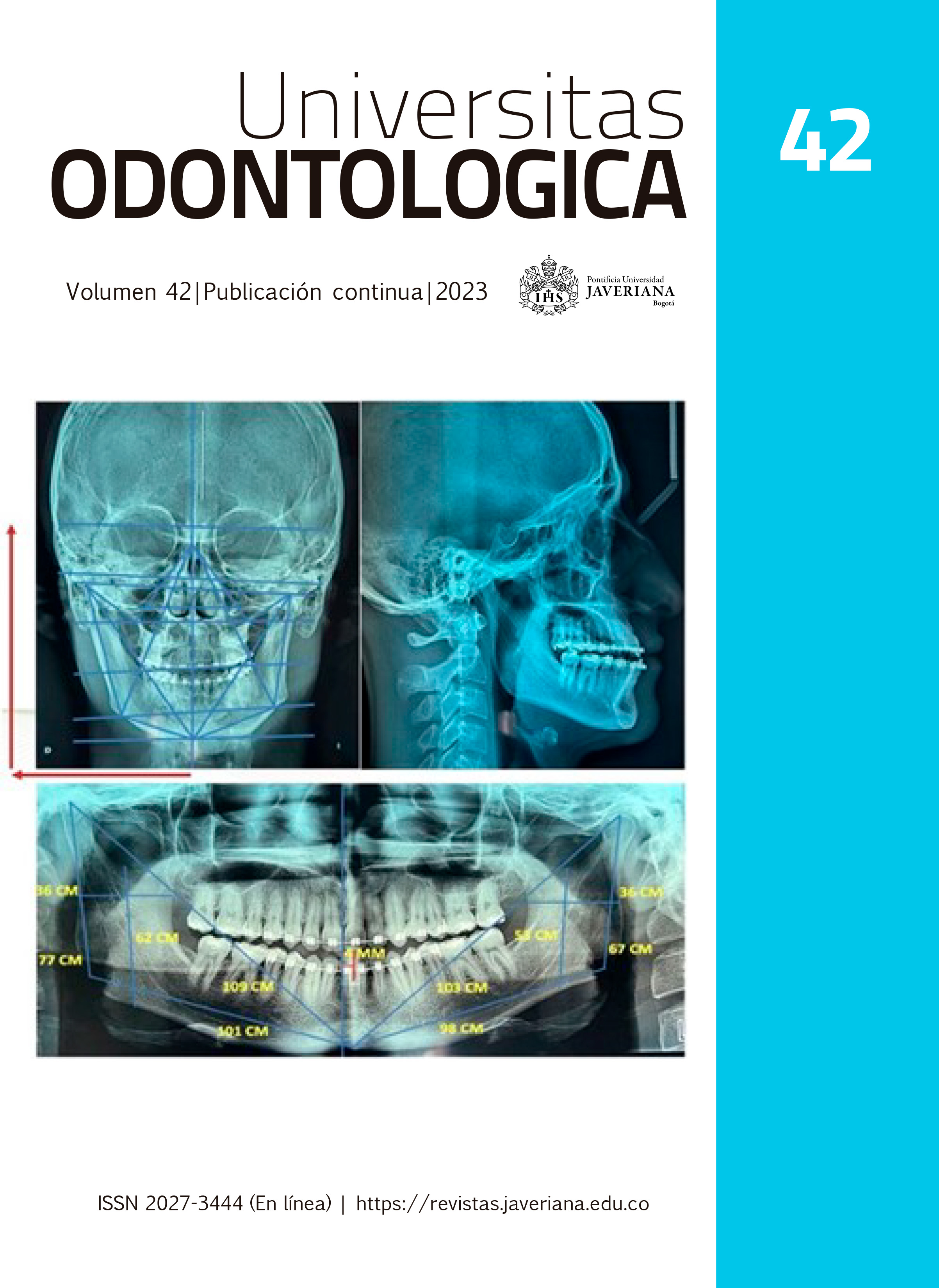Abstract
Objectives: To determine the existence of DNA damage in healthy patients undergoing removable metal orthopedic treatment through micronucleus test in oral mucosa cells. Methods: Samples were collected before the appliance adaptation and 30 days later, the buccal cells of each individual were collected by gently brushing the internal part of the cheeks with a cytological brush. The plates were immersed in a Coplin jar with 0.2% Light Green solution for 1 minute, and then were rinsed with deionized water or Milli Q to remove excess dye. Later, these were placed on a drying plate between 50ºC and 80ºC for 10 to 15 minutes. Results: Compared with the initial samples, after 1 month of orthopedic treatment, a significant increase in the frequency of cells with micronuclei, nuclear budding and karyorrhexis was observed. No changes or evidence of an increase were observed in cells with condensed chromatin. Conclusions: The stages of nuclear alteration that took place during the development of this study were MN frequency, nuclear budding and karyorrhexis, registering a higher frequency in the second sampling and attributed to the presence of removable appliances in the patients.
Pyknosis, karyolysis and karyorrhexis do not constitute stages of nuclear alteration, the latter being the one with the greatest trend observed in the first and second sampling. For this stage a significant increase in number was found, attributed to the presence of removable appliances in the patients.
Maia LH, Lopes Filho H, Ruellas AC, Araújo MT, Vaitsman DS. Corrosion behavior of self-ligating and conventional metal brackets. Dental Press J Orthod. 2014 Mar-Apr;19(2):108-14. https://dx.doi.org/10.1590/2176-9451.19.2.108-114.oar
Macedo Menezes L, Matos de Souza R, Schmidt Dolci G, Dedavid BA. Biodegradação de braquetes ortodônti-cos: análise por microscopia eletrônica de varredura. Dental Press J Orthod. 2010 Jun; 15(3):48-51. https://doi.org/10.1590/S2176-94512010000300006
Downarowicz P, Mikulewicz M. Trace metal ions release from fixed orthodontic appliances and DNA damage in oral mucosa cells by in vivo studies: A literature review. Adv Clin Exp Med. 2017 Oct; 26(7): 1155-1162. https://doi.org/10.17219/acem/65726
Piñeda-Zayas A, Menendez Lopez-Mateos L, Palma-Fernández JC, Iglesias-Linares A. Assessment of metal ion accumulation in oral mucosa cells of patients with fixed orthodontic treatment and cellular DNA damage: a systematic review. Crit Rev Toxicol. 2021 Aug; 51(7): 622-633. https://doi.org/10.1080/10408444.2021.1960271
Fernández-Miñano E, Ortiz C, Vicente A, Calvo Guirado JL, Ortiz AJ. Metallic ion content and damage to the DNA in oral mucosa cells of children with fixed orthodontic appliances. Biometals. 2011 Oct; 24(5): 935. https://doi.org/10.1007/s10534-011-9448-z
Menezes LM de, Freitas MPM, Gonçalves TS. Biocompatibilidade dos materiais em Ortodontia: mito ou realida-de? Rev Dent Press Ortodon Ortop Facial. 2009 Mar; 14(2): 144–157. https://doi.org/10.1590/S1415-54192009000200016
Westphalen GH, Menezes LM. Citotoxicidade e genotoxicidade de materiais ortodônticos.158 f. Tese (Doutorado em Odontologia) - Pontifícia Universidade Católica do Rio Grande do Sul, Porto Alegre; 2009.
Shashikala R, Indira AP, Manjunath GS, Rao KA, Akshatha BK. Role of micronucleus in oral exfoliative cytology. J Pharm Bioallied Sci. 2015 Aug; 7(Suppl 2): S409-413. https://doi.org/10.4103/0975-7406.163472
Bansal H, Sandhu VS, Bhandari R, Sharma D. Evaluation of micronuclei in tobacco users: A study in Punjabi population. Contemp Clin Dent. 2012 Apr; 3(2): 184-187. https://doi.org/10.4103/0976-237X.96825
Ramesh G, Chaubey S, Raj A, Seth RK, Katiyar A, Kumar A. Micronuclei assay in exfoliated buccal cells of radiation treated oral cancer patients. J Exp Ther Oncol. 2017 Nov; 12(2): 121-128
Tak A, Metgud R, Astekar M, Tak M. Micronuclei and other nuclear anomalies in normal human buccal mucosa cells of oral cancer patients undergoing radiotherapy: a field effect. Biotech Histochem. 2014 Aug; 89(6): 464-469. https://doi.org/10.3109/10520295.2014.904925
Martín-Cameán A, Jos Á, Mellado-García P, Iglesias-Linares A, Solano E, Cameán AM. In vitro and in vivo evidence of the cytotoxic and genotoxic effects of metal ions released by orthodontic appliances: A review. Environ Toxicol Pharmacol. 2015 Jul; 40(1): 86-113. https://doi.org/10.1016/j.etap.2015.05.007
Thomas P, Holland N, Bolognesi C, Kirsch-Volders M, Bonassi S, Zeiger E, Knasmueller S, Fenech M. Buccal micronucleus cytome assay. Nat Protoc. 2009; 4(6): 825-837. doi: https://doi.org/10.1038/nprot.2009.53
Ministerio de Salud de Colombia. 8430 resolución 008430 del 4 de octubre de 1993, por la cual se establecen las normas científicas; Bogotá, Colombia: el Ministerio; 1993.
World Medical Association General Assembly. World Medical Association Declaration of Helsinki: ethical principles for medical research involving human subjects. J Int Bioethique. 2004 Mar;15(1): 124-129
Shashikala, R.; Indira, AP 1 ; Manjunath, GS; rao, K. Arathi; Akshatha, BK 2 ,. Papel del micronúcleo en la citología exfoliativa oral.. Journal of Pharmacy and Bioallied Sciences 7 (Suplemento 2): p S409-S413, agosto de 2015. | DOI: 10.4103/0975-7406.163472
Amini F, Jafari A, Amini P, Sepasi S. Metal ion release from fixed orthodontic appliances--an in vivo study. Eur J Orthod. 2012 Feb; 34(1): 126-30. https://doi.org/10.1093/ejo/cjq181

This work is licensed under a Creative Commons Attribution 4.0 International License.
Copyright (c) 2023 Martha LIgia Vergara Mercado, Shirley Salcedo Arteaga, Lyda Marcela Espitia Pérez, Luis David Hoyos Estrada, Valeria Andrea Gómez Montiel


